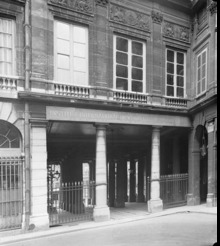International Institute for Intellectual Cooperation
The International Institute for intellectual cooperation (IIGZ) (fr. Institut international de coopération intellectuelle , Eng. International Institute for Intellectual Cooperation a) was an international organization for the promotion of scientific and intellectual exchange that existed and 1926-1946 based in Paris had . The IIGZ is considered to be the predecessor institution of UNESCO and was affiliated to the League of Nations .
International Commission for Intellectual Cooperation
This was preceded in 1921, at the suggestion of France, by the decision of the League of Nations and in January 1922 the official establishment of the " International Commission for Intellectual Cooperation " (ICGZ) (Commission internationale de coopération intellectuelle, CICI) with its seat in Geneva, chaired by Henri Bergson , 12th up to 19 prominent members were included, including Albert Einstein , Jagadish Chandra Bose , Marie Curie , Kristine Bonnevie , Paul Painlevé , Alfredo Rocco , Leonardo Torres-Quevedo and Gonzague de Reynold . In 1925 the Dutchman HA Lorentz became the chairman, from 1928 to 1939 the British Gilbert Murray . The annual meetings in Geneva took place in August. The body of busy dignitaries, scientists, and intellectuals proved to be ineffective. Below there were also expert commissions and national commissions such as the German Commission for Intellectual Cooperation .
Foundation and tasks of the institute
The IIGZ was therefore founded as a permanent executive body of the still existing IKGZ and was mainly supported by France, which also provided the majority of the staff and paid 80 percent of the costs. The institute's first two general directors, Julien Luchaire (until 1930) and Henri Bonnet (1930–1940), were French. Like UNESCO, the IIGZ and the IKGZ had national commissions that organized cooperation with the headquarters. Jean-Jacques Mayoux took over the transition to UNESCO in 1945.
The main tasks were questions of copyright and intellectual property , translations and statistics in the field of culture, for which some resolutions of the General Assembly were prepared.
It was also about "moral disarmament", i. H. the IIGZ was intended to complement the League of Nations, which secured peace through political measures such as disarmament and dispute settlement. The readiness of the peoples for peace should be strengthened through educational and cultural measures. The subject matter in school books should be written less chauvinistic and, especially in the subject of history, more in the spirit of international understanding. The Geneva General Assembly in 1926 approved the Casares Resolution in this sense. The IIGZ also strived for the peaceful use of radio and cinema, organized summer courses for young people at the League of Nations in Geneva and other educational measures for a better understanding of the League of Nations.
rating
Like the League of Nations itself, the Institute for Intellectual Cooperation ultimately failed in its main task of securing peace. On the other hand, it laid important foundations for the emergence of the United Nations and its affiliated organizations and for European understanding after the Second World War . One reason for the institute's unsuccessful work was the international climate characterized by national rivalries. In addition, international cooperation did not become a mass movement in the interwar period, but was only supported by part of the intellectual elite. In the area of cultural cooperation, in which France was particularly committed, England in particular , but also countries such as Sweden and the German Reich , expressed suspicion of cultural imperialism and suspected that the French involvement was primarily due to political ulterior motives for the implementation of French goals.
literature
- Isabella Löhr: The League of Nations and the globalization of intellectual property rights in the interwar period . In: UFITA 2008 / I, pp. 67–90.
- Christine Manigand: Elites et coopération culturelle internationale dans le cadre de la Société des Nations . In: Marta Petricioli, Donatella Cherubini (eds.): Pour la paix en Europe. Institutions et société civil dans l'entre-deux-guerres (= L'Europe et les Europes - 19e et 20e siècles , vol. 7). PIE Peter Lang, Brussels a. a. 2007, ISBN 978-90-5201-364-0 , pp. 57-71.
- Corinne A. Pernet: Twists, Turns and Dead Alleys. The League of Nations and Intellectual Cooperation in Times of War . In: Journal of Modern European History , Vol. 12 (2004), Issue 3, pp. 342–358 ( online ).
- Jean-Jacques Renoliet: L'UNESCO oubliée. La SDN et la coopération intellectuelle 1919-1946 . Publications de la Sorbonne, Paris 1999 ISBN 978-2-85944-384-9
- Phan Ti Tu: La coopération intellectuelle sous la Société des Nations . Droz, Geneva 1962.
See also
Footnotes
- ^ ICIC. 1926, Retrieved March 25, 2019 .
- ^ Corinne A. Pernet: "In the Spirit of Harmony"? The Politics of (Latin American) History at the League of Nations . In: Alan McPherson, Yannick Wehrli (eds.): Beyond Geopolitics. New Histories of Latin America at the League of Nations . University of New Mexico Press, Albuquerque 2015, ISBN 978-0-8263-5165-4 , pp. 135–153 ( online )
